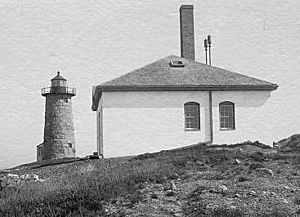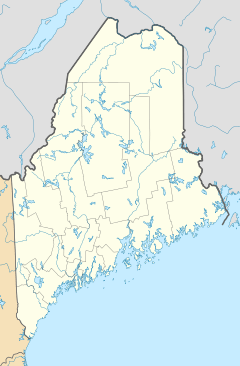Libby Island Light facts for kids
 |
|
| US Coast Guard photo | |
|
|
|
| Location | Machias Bay, Maine |
|---|---|
| Coordinates | 44°34′5.985″N 67°22′2.555″W / 44.56832917°N 67.36737639°W |
| Year first constructed | 1822 |
| Year first lit | 1848 (current structure) |
| Automated | 1974 |
| Tower shape | Conical Granite Tower |
| Markings / pattern | White |
| Focal height | 91 feet (28 m) |
| Original lens | 4th order Fresnel lens |
| Current lens | VRB-25 |
| Range | 18 nautical miles (33 km; 21 mi) |
| Characteristic | Fl (2) W 20s |
| Fog signal | HORN: 1 every 15s |
| USCG number | 1-1120 |
Libby Island Light is a cool lighthouse located on Libby Island. It helps ships find their way safely into Machias Bay in Machiasport, Maine. This important light station started operating in 1817. The strong granite tower you see today was built in 1823. It's still an active light, guiding boats even now! Libby Island Light was recognized as a historic place in 1976.
Contents
Discover Libby Island Light: A Maine Landmark
Libby Island Light is an important part of Maine's coast. It stands tall on South Libby Island. This island is one of two islands, known as the Libby Islands. They mark the main way to enter Machias Bay from the ocean.
What Does Libby Island Light Look Like?
The main part of the light station is the lighthouse itself. It's a tall tower made of unpainted granite. The tower is about 42 feet (13 m) high. Its base is 16 feet (4.9 m) wide, and the top part is about 12 feet 4 inches (3.76 m) wide.
The lighthouse is on the southern side of the island. Next to it, on the west, is a building for the fog signal. There's also a place for boats to land on the northern shore. A small helipad, for helicopters, is near the center of the island.
The History of Libby Island Light
The idea for a light station here was approved in 1817. The very first tower was made of wood. Sadly, a strong wind blew it down around 1822.
The granite tower we see today was built in 1823. A house for the lighthouse keeper was added the next year. In 1855, a special Fresnel lens was put into the tower. This type of lens helps make the light much brighter and stronger.
How the Lighthouse Changed Over Time
More buildings were added in 1856, including a fog signal. The original keeper's house was later taken down. The current fog signal building was built in 1884.
In 1974, the lighthouse became "automated." This means machines took over the job of keeping the light on. No one needed to live there anymore. In 2000, it was updated to use solar power, which is energy from the sun.
Who Owns Libby Island Light Today?
Today, the lighthouse tower belongs to the United States Fish and Wildlife Service. Because of this, the lighthouse is not open for people to visit inside. It continues to be an important guide for ships.


